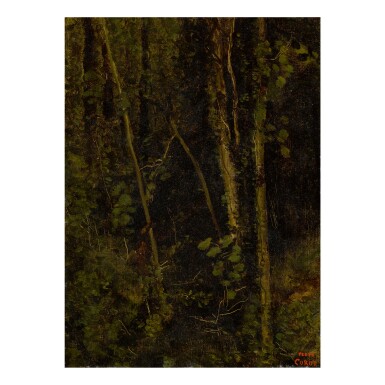19th Century European Art
19th Century European Art

Property of a Japanese Private Collector
JEAN-BAPTISTE-CAMILLE COROT | FOURRÉ DE BALIVEAUX
Auction Closed
January 31, 04:23 PM GMT
Estimate
20,000 - 30,000 USD
Lot Details
Description
Property of a Japanese Private Collector
JEAN-BAPTISTE-CAMILLE COROT
French
1796 - 1875
FOURRÉ DE BALIVEAUX
stamped with the VENTE COROT stamp (lower right); VENTE COROT wax seal (on the reverse)
oil on canvas laid down on board
12½ by 9½ in.
31.7 by 24.1 cm
The artist's studio (and sold, his posthumous sale, Hôtel Drouot, Paris, May 26-28, 1875, lot 111, as Jeunes Arbres, étude)
Étienne Arago, Paris (acquired at the above sale)
Ingersoll-Smouse
Tedesco, no. 11-206 (acquired from the above, August 1925)
Georges Bernheim, Paris, no. 13261 (acquired from the above, September 1925)
Shigetaro Fukushima, Paris and Tokyo (according to a label on the reverse)
Private Collection, Japan (acquired in Tokyo circa 1935)
Thence by descent
Alfred Robaut, L'oeuvre de Corot, catalogue raisonné et illustré, Paris, 1965, vol. II, p. 226, no. 650, illustrated p. 227
In an 1851 review of the Salon des Artistes Français, the critic Auguste Desplaces wrote of Jean-Baptiste-Camille-Corot,
“M. Corot excels… in reproducing vegetation in its fresh beginnings; he marvelously renders the firstlings of a new world. Grass that has as yet felt only the warmth of May, the first new leaves just emerged from the bud, all that adolescence of newly green nature finds in M. Corot an innocent and well-informed interpreter. This is no academic tracing, no copy of earlier masters: one senses a familiarity with and inspired knowledge of the subject” (quoted in Gary Tinterow, Michael Pantazzi and Vincent Pomarède, Corot, exh. cat., The Metropolitan Museum of Art, New York, 1996, p. 226-7).
Fourré de Baliveaux depicts a thicket of saplings that have just begun to bud. It is evident that the artist, as Desplaces suggests, closely studied changes in nature brought on by the turning of seasons and recorded the first signs of spring. It evocatively illustrates Corot’s inventiveness within the landscape genre and his ability to experiment with perspective and color.
We would like to thank Martin Dieterle and Claire Lebeau for kindly confirming the authenticity of this lot.
